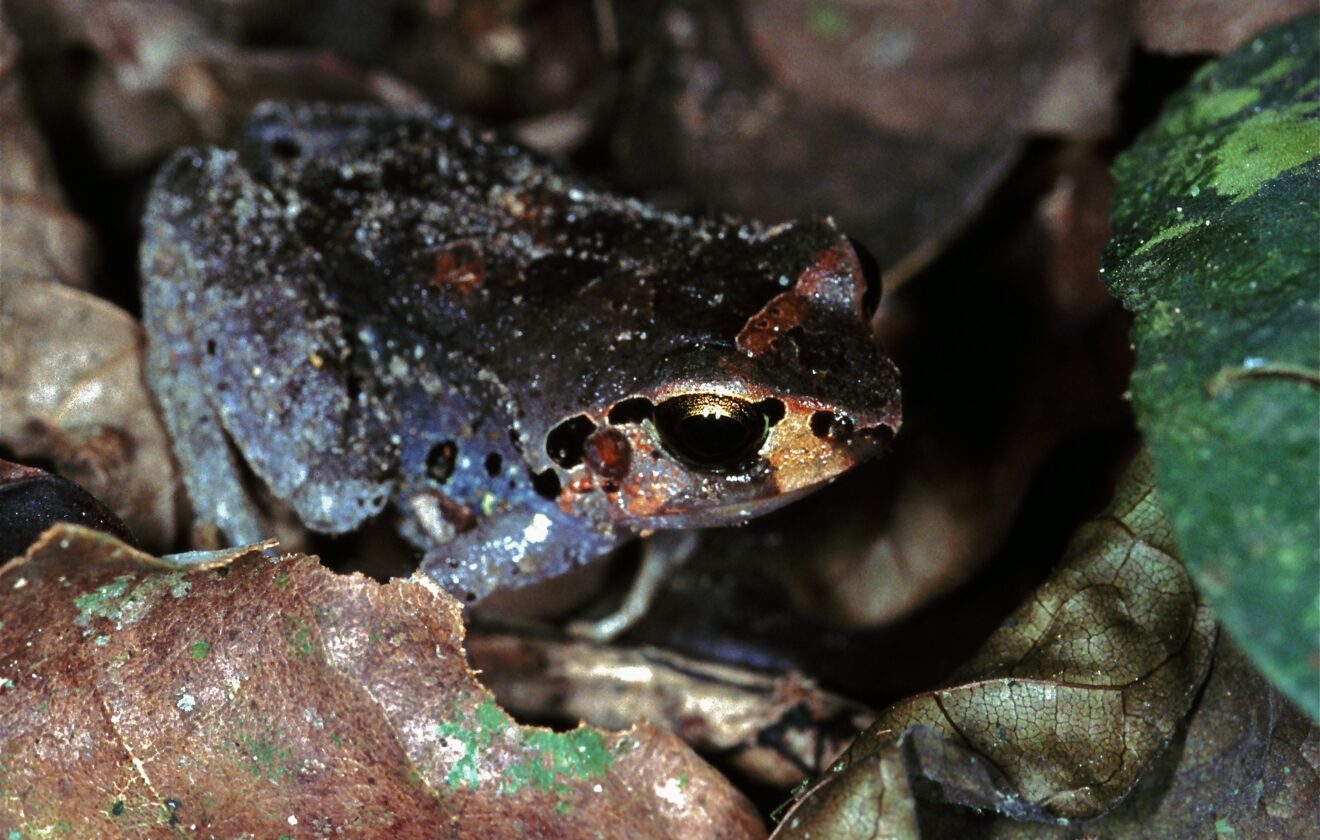- Arthroleptis variabilis: Unveiling Africa's Secretive Forest Frog
- Taxonomy and Classification of Arthroleptis variabilis
- Natural Habitat: Hidden Treasures of Africa's Rainforests
- Physical Characteristics: Master of Camouflage and Adaptation
- Behavior and Life Cycle: Extraordinary Adaptations
- Ecological Role: A Vital Forest Guardian
- Threats and Conservation Status: Lessons from the Forest Floor
- Cultural and Scientific Significance
- Conclusion: The Hidden Jewel of the Leaf Litter
Arthroleptis variabilis: Unveiling Africa’s Secretive Forest Frog#
Deep within the humid embrace of Africa’s evergreen forests, cloaked beneath the dense leaf litter and hidden in shadows, lives a small, cryptic amphibian with an incredible knack for camouflage and adaptation. This elusive creature is Arthroleptis variabilis, a frog whose Latin name hints precisely at what makes it remarkable—the astonishing variability of its physical appearance. Although modest in size and difficult to spot, this species offers significant ecological insights, highlighting the profound interconnectedness and delicate balance of rainforest ecosystems.
Commonly known as the Variable Squeaker Frog due to the high-pitched chirps and delicate squeaks it emits during rainy nights, Arthroleptis variabilis belongs to a complex yet fascinating genus characterized by direct-developing frogs. This means they bypass the aquatic tadpole stage entirely, developing directly within terrestrial eggs—a remarkable adaptation for thriving within moisture-rich yet often water-deficient forest floors.
Taxonomy and Classification of Arthroleptis variabilis#
Arthroleptis variabilis is nestled comfortably within the extensive Arthroleptidae family, an intriguing and diverse group of frogs primarily endemic to Sub-Saharan Africa. More specifically, this species falls under the Arthroleptis genus, identifying it as part of a lineage deeply intertwined with forest habitats. First described scientifically by Norwegian zoologist Lars Gabriel Andersson in 1905, its classification has provided valuable insight into amphibian evolution in African tropical climates.
Close relatives within the genus, such as Arthroleptis xenochirus and Arthroleptis poecilonotus, share similar environments and behavioral traits, although the variability in coloration and morphological detail in variabilis sets it apart definitively. Accurate taxonomic understanding doesn’t merely serve the scientific sphere—it also guides crucial conservation strategies aimed at preserving biodiversity in rapidly vanishing habitats.
Natural Habitat: Hidden Treasures of Africa’s Rainforests#
To journey into the realm of Arthroleptis variabilis is to venture deep into the rainforests of Central and West Africa. Its natural range primarily spans countries such as Cameroon, Equatorial Guinea, Gabon, Nigeria, and the Republic of the Congo. In these rich regions of evergreen and semi-deciduous tropical forests, the frog seeks refuge beneath layers of fallen leaves, amongst decomposing logs, or tucked neatly within the twisting roots of ancient trees.
An Expert of Leaf Litter#
The forest’s understory provides the ideal environment. The species thrives in warm, moist microhabitats offered by a canopy shading the ground below and sustaining just enough humidity to support their amphibian skin. This forest stratum addressed the frog’s niche demands excellently, offering protection from both meandering predators and extreme temperatures that could damage this sensitive amphibian.
Interestingly, the frog’s microhabitat selection has significant ecological implications, as the species actively participates in nutrient recycling. By consuming invertebrates and occasionally falling prey to larger forest inhabitants, Arthroleptis variabilis intricately weaves into the tapestry of forest life, illuminating an invaluable role played by small organisms in maintaining ecological balance.
Physical Characteristics: Master of Camouflage and Adaptation#
A hallmark of Arthroleptis variabilis is its striking variability in color, pattern, and even body size, ranging typically between 20 to 40 millimeters in length. The intricate and often cryptic patterns on its skin range from shades of earth-browns, subtle greys, vivid greens, to occasional splashes of rusty reds or yellows. This kaleidoscope of possibilities enables these frogs to meld seamlessly with their leafy backgrounds, taking cover from the keen eyes of predatory birds, snakes, and small mammals prowling the forest floor.
Skin and Shape: Built for Survival#
Its skin, moist yet skillfully textured, is adapted to respiratory exchange, maximizing oxygen absorption in damp habitats while also supporting unparalleled camouflage talents. Limb proportions in Arthroleptis variabilis vary slightly with locations and subpopulations—another fascinating glimpse into how species can adapt morphology according to specific microenvironments.
Behavior and Life Cycle: Extraordinary Adaptations#
Beneath the cover of nightfall, rain showers awaken a symphony on the rainforest floor, highlighting the secretive lives of this mysterious frog. With its signature squeaks and chirps audible after rainfall, male Arthroleptis variabilis diligently call out to prospective females. Strategic perching on elevated leaf structures provides perfect acoustic amplification, subtly attracting mates from hidden corners.
Reproduction: An Incredible Leap From Egg to Froglet#
Perhaps one of the most remarkable traits of this species—and indeed, its genus—is direct development. Unlike many amphibian relatives, Arthroleptis variabilis bypasses aquatic larval stages entirely. Females carefully deposit small clusters of eggs nestled beneath damp leaves or under logs, where they remain safe and concealed from predators. Within these translucent spheres, embryos steadily metamorphose, emerging from their eggs shortly thereafter as tiny replicas of adults, fully formed yet miniature.
Diet and Foraging Techniques#
A skilled predator, Arthroleptis variabilis hunts mainly tiny insects, mites, and occasionally spiders and other small invertebrates inhabiting forest floor detritus. Predominantly nocturnal, these frogs rely heavily on ambush techniques and excellent camouflage, patiently waiting for unsuspecting prey to stumble within reach before striking with precision.
Ecological Role: A Vital Forest Guardian#
Despite its diminutive stature, Arthroleptis variabilis plays a crucial ecological role: controlling insect populations, regulating smaller invertebrates’ numbers, and serving as prey for many larger forest species. Furthermore, because amphibians like this frog have semipermeable skins sensitive to environmental changes, they act as natural bio-indicators, revealing subtle shifts in forest ecosystems crucial to conservationists and ecologists monitoring ecosystem health.
Threats and Conservation Status: Lessons from the Forest Floor#
Currently listed as “Least Concern” by the International Union for Conservation of Nature (IUCN), Arthroleptis variabilis nonetheless faces threats—both direct and indirect—that compromise its long-term viability. Forest habitat loss driven by expanding agriculture, logging concessions, palm oil plantations, and urban developments poses significant barriers to the frog’s dispersal and survival.
Emerging Risks: Climate, Disease, and Fragmentation#
Beyond habitat destruction, the threat emerging from global climate change is ever-present, with fluctuations in rainfall patterns and increased temperature altering suitable habitats beyond the species’ tolerance limits. Although chytrid fungus—a devastating amphibian disease—is more commonly reported elsewhere, continuous monitoring remains essential to ensure African amphibians remain unaffected by its potentially lethal impacts.
Current Conservation Initiatives#
Conservation efforts targeted explicitly towards Arthroleptis variabilis remain underrepresented, prompting a need for enhanced research, monitoring programs, and environmental education in local communities. Implementing facets of sustainable land management, forest rehabilitation projects, and governmental policy changes can immensely benefit forest-dependent species, positively impacting conservation outcomes for the entire rainforest ecosystem.
Cultural and Scientific Significance#
While Arthroleptis variabilis might rarely feature prominently in local folklore or traditional beliefs compared to larger, brighter amphibian cousins, its role in ecosystem health holds deep scientific significance. Amphibians are a frequent subject for climate monitoring studies, ecological health assessments, and evolutionary research. The exceptional reproductive adaptation displayed by Arthroleptis variabilis has profound implications for understanding amphibian evolution, adaptation, and climate resilience processes.
Conclusion: The Hidden Jewel of the Leaf Litter#
Though tiny and seemingly modest, Arthroleptis variabilis represents nature’s own testament to resilience, adaptation, and biodiversity. This small frog encapsulates precisely why maintaining Earth’s biodiversity matters profoundly—for ecosystems, for science, and, ultimately, for us. Every species uniquely contributes to sustaining the delicate balance supporting life on our planet.
To truly appreciate Arthroleptis variabilis is to recognize our profound duty to protect the richness of our rainforests from lasting damage, remembering that each creature—no matter how small—plays an irreplaceable role. Explore, share your newfound love for hidden forest gems, support conservation initiatives, and together, let’s ensure landscapes, where frogs sing in gentle whispers among the shadows, are preserved far into the future.















